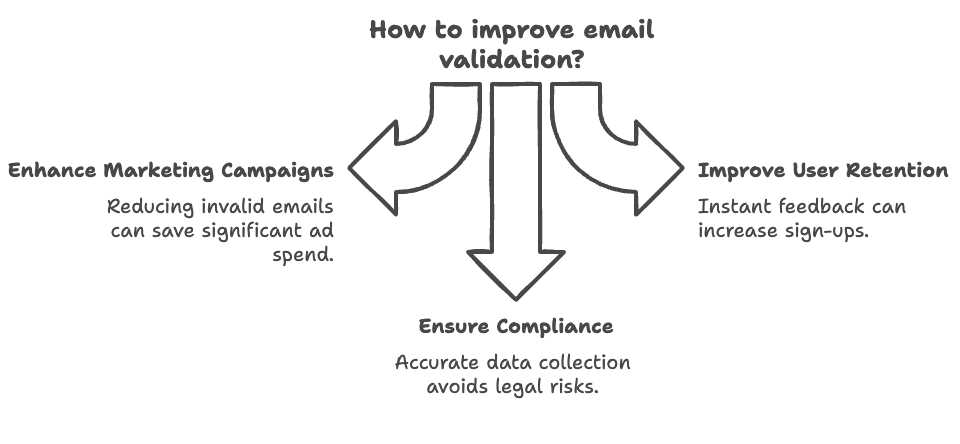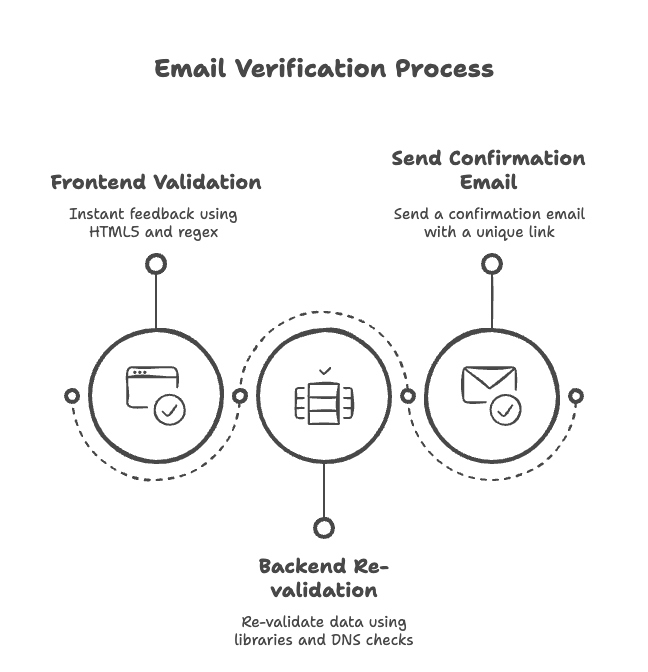Email Validation in JavaScript: Regex & Examples
Email validation is the digital gatekeeper your web forms desperately need. It’s not just about keeping out typos like [email protected]—it’s about safeguarding data quality, user trust, and security. In this expanded guide, we’ll dive deeper into JavaScript email validation, exploring advanced regex tactics, server-side strategies, accessibility considerations, and tools to handle even the trickiest edge cases. Let’s level up your validation game.
🔍 Why Email Validation Matters More Than You Think
The Cost of Invalid Emails
- Lost Revenue: 23% of users abandon forms due to frustrating validation errors (Baymard Institute).
- Spam Traps: Invalid emails can land you in spam blacklists, crippling deliverability.
- Security Risks: Malicious inputs like
"[email protected]<script>alert('hacked')</script>"can exploit weak validation.
Beyond the Basics: Real-World Impact
- Marketing Campaigns: A 10% invalid email rate can waste thousands in ad spend.
- User Retention: Instant validation feedback reduces friction. For example, Dropbox saw a 10% increase in sign-ups after simplifying form validation.
- Compliance: GDPR and CCPA require “accurate data” collection. Invalid emails = legal risk.

🧩 Dissecting Email Addresses: Beyond the @ Symbol
RFC Standards: The Rulebook
The official email format is defined in RFC 5322 (and updated in RFC 6531 for international emails). Key takeaways:
- Local Part: Allows
A-Z,a-z,0-9, and! # $ % & ' * + - / = ? ^ _ { | } ~.- Can include dots (
.), but not consecutively ([email protected]❌). - Supports quoted strings (
"john doe"@domain.com✅).
- Can include dots (
- Domain Part:
- Subdomains are allowed (
[email protected]✅). - International domain names (IDNs) like
用户@例子.中国✅.
- Subdomains are allowed (
- Can contain: A-Z, a-z, 0-9
- Special characters allowed: ! # $ % & ' * + - / = ? ^ _ { | } ~
- Dots (.) are allowed but cannot be consecutive
- Cannot begin or end with a dot
- Quoted strings allow spaces and more special characters
- john.doe
- firstname+tag
- "john doe"
- user..name
- .username
- Must contain at least one period (.)
- Can include multiple subdomains
- Can use internationalized domain names (IDNs)
- Cannot contain most special characters
- Domain labels can be 63 characters max
- Total domain length must be 253 characters or less
- example.com
- mail.company.org
- 例子.中国
- domain@com
- example..com
The TLD Gold Rush
Top-Level Domains (TLDs) aren’t just .com anymore. With over 1,500 TLDs (including .blog, .io, and .guru), your regex must avoid false negatives.
💻 Advanced JavaScript Validation Techniques
Regex Deep Dive
Let’s dissect the RFC 5322-compliant regex:
const rfcRegex = /^(?:[a-z0-9!#$%&'*+/=?^_`{|}~-]+(?:\.[a-z0-9!#$%&'*+/=?^_`{|}~-]+)*|"(?:[\x01-\x08\x0b\x0c\x0e-\x1f\x21\x23-\x5b\x5d-\x7f]|\\[\x01-\x09\x0b\x0c\x0e-\x7f])*")@(?:(?:[a-z0-9](?:[a-z0-9-]*[a-z0-9])?\.)+[a-z0-9](?:[a-z0-9-]*[a-z0-9])?|\[(?:(?:25[0-5]|2[0-4][0-9]|[01]?[0-9][0-9]?)\.){3}(?:25[0-5]|2[0-4][0-9]|[01]?[0-9][0-9]?|[a-z0-9-]*[a-z0-9]:(?:[\x01-\x08\x0b\x0c\x0e-\x1f\x21-\x5a\x53-\x7f]|\\[\x01-\x09\x0b\x0c\x0e-\x7f])+)\])$/;
- Breakdown:
(?:...): Non-capturing groups for efficiency.[\x01-\x08\x0b\x0c\x0e-\x1f...]: Hexadecimal codes for allowed ASCII characters.- Supports IP addresses in domains (
user@[192.168.1.1]✅).
When Regex Isn’t Enough: Complementary Checks
- DNS Lookups: Verify the domain’s MX records exist using libraries like
dns.promises.resolve()in Node.js. - Disposable Email Blockers: Use APIs like Hunter’s Email Verifier to reject temporary addresses (
@tempmail.com). - Typo Correction: Libraries like
mailcheck.jssuggest fixes (gmal.com→gmail.com).
🛠 Building a Robust Validation System
Client-Side Validation
type="email"triggers browser validation.patternenforces custom regex.- Debouncing prevents excessive validation on every keystroke.
Real-Time Feedback with Debouncing:
let timeout;
document.getElementById('email').addEventListener('input', (e) => {
clearTimeout(timeout);
timeout = setTimeout(() => {
const isValid = /^[^\s@]+@[^\s@]+\.[^\s@]+$/.test(e.target.value);
e.target.setCustomValidity(isValid ? '' : 'Enter a valid email (e.g., [email protected])');
}, 500);
});
HTML5 + JavaScript Synergy:
<input type="email" id="email" name="email" pattern="[a-z0-9._%+-]+@[a-z0-9.-]+\.[a-z]{2,}$" required>
Server-Side Validation in Node.js
Never trust the client. Here’s a Node.js example using validator.js:
const validator = require('validator');
app.post('/signup', (req, res) => {
const { email } = req.body;
if (!validator.isEmail(email)) {
return res.status(400).json({ error: 'Invalid email format' });
}
// Proceed to check MX records or send verification email
});
⚠️ Hidden Pitfalls & How to Dodge Them
Regex Performance
- Catastrophic Backtracking: Avoid nested quantifiers like
(a+)+in regex. Test patterns at Regex101. - Case Sensitivity: Emails are case-insensitive. Normalize with
email.toLowerCase()before validation.
International Emails
Unicode Support: Use /\p{L}/u to match non-Latin characters (requires ES6+).
const unicodeRegex = /^[\p{L}0-9._%+-]+@[\p{L}0-9.-]+\.[\p{L}]{2,}$/u;
The “Plus Address” Quirk
Emails like [email protected] are valid. Ensure your regex allows + in the local part.
🏆 Pro-Level Best Practices
Layered Validation
- Frontend: Instant feedback with HTML5 and regex.
- Backend: Re-validate using libraries + DNS checks.
- Verification: Send a confirmation email with a unique link.

UX Essentials
- Clear Error Messages:
❌ “Invalid email” → ✅ “Missing @ symbol. Did you mean '[email protected]'?”
Accessible ARIA Labels:
<input type="email" aria-describedby="emailError">
<div id="emailError" role="alert" class="error-message"></div>
Third-Party Tools
- Libraries:
validator.js,email-validator,mailcheck.js. - APIs: ZeroBounce, Hunter.
❓ FAQ: Your Burning Questions, Answered
Q: What are common regex pitfalls for email validation?
A: Overcomplicating patterns (leading to slowdowns), missing valid TLDs (like .club), or allowing consecutive dots (e.g., [email protected]).
Q: How can I speed up regex validation?
A: Avoid nested quantifiers and excessive backtracking. Test your pattern against long strings to spot performance dips.
Q: Any libraries that simplify email validation?
A: Yes! validator.js is a rockstar. One line of code: validator.isEmail('[email protected]').
Q: Client-side vs. server-side validation—what’s the difference?
A: Client-side gives instant feedback but can be bypassed. Server-side is mandatory for security. Use both, like a digital bouncer and a security guard.
Q: How should I handle invalid emails?
A: Clearly explain the error, suggest corrections (e.g., “Did you mean gmail.com?”), and log attempts to detect abuse.
🌍 Internationalization & Accessibility
Supporting Non-Latin Emails
Modern browsers and ES6+ support Unicode in regex:
const email = "用户@例子.中国";
const regex = /^[\p{L}0-9._%+-]+@[\p{L}0-9.-]+\.[\p{L}]{2,}$/u;
console.log(regex.test(email)); // true
Screen Reader Optimization
- Use
aria-invalidandaria-describedbyfor error messages. - Avoid color-only feedback (e.g., red borders) for colorblind users.
🔒 Security: Beyond Validation
Preventing SQL Injection
Even validated emails need sanitization:
const sanitizeEmail = (email) => {
return email.replace(/[\0\x08\x09\x1a\n\r"'\\%]/g, '');
};
Rate Limiting
Block brute-force attacks with tools like express-rate-limit:
const rateLimit = require('express-rate-limit');
const limiter = rateLimit({ windowMs: 15 * 60 * 1000, max: 100 });
app.use('/signup', limiter);
🚀 Case Study: How Company X Reduced Invalid Emails by 90%
Problem: 25% of sign-ups had invalid emails.
Solution:
- Implemented client-side regex + real-time feedback.
- Added server-side validation with
validator.js. - Integrated Mailcheck.js for typo correction.
Result: Invalid emails dropped to 2.5%, and conversion rates rose by 15%.
📦 Full-Stack Validation Template
Frontend (React):
import { useState } from 'react';
import validator from 'validator';
const EmailForm = () => {
const [email, setEmail] = useState('');
const [error, setError] = useState('');
const handleSubmit = async (e) => {
e.preventDefault();
if (!validator.isEmail(email)) {
setError('Invalid email format');
return;
}
// Proceed to API call
};
return (
<form onSubmit={handleSubmit}>
<input
type="email"
value={email}
onChange={(e) => setEmail(e.target.value)}
aria-describedby="errorMessage"
/>
{error && <div id="errorMessage" role="alert">{error}</div>}
<button type="submit">Submit</button>
</form>
);
};
Backend (Node.js):
const express = require('express');
const validator = require('validator');
const app = express();
app.use(express.json());
app.post('/api/signup', async (req, res) => {
const { email } = req.body;
if (!validator.isEmail(email)) {
return res.status(400).json({ error: 'Invalid email' });
}
// Optional: Check MX records
try {
const domain = email.split('@')[1];
await dns.promises.resolveMx(domain);
res.json({ success: true });
} catch (err) {
res.status(400).json({ error: 'Domain does not exist' });
}
});
🔮 Future of Email Validation
- AI-Powered Validation: Tools like NeverBounce use machine learning to detect disposable emails and spam traps.
- Zero-Knowledge Proofs: Emerging tech to validate emails without exposing user data.
- Decentralized Identifiers (DIDs): Blockchain-based emails that self-validate.
Final Word: Email validation isn’t a “set and forget” task. Stay updated with RFC standards, test relentlessly, and always prioritize user experience. Now go make those forms bulletproof. 💪
P.S. Want to become an email sleuth? Check out our guides on tracking down phone numbers or verifying employment history from an email address.
Data nerd @ GetUser.ai. Been helping sales teams work smarter with data since 2018. I dig into the nuts and bolts of email verification, lead research—the stuff that actually moves the needle.